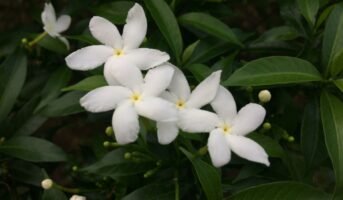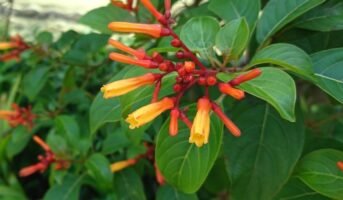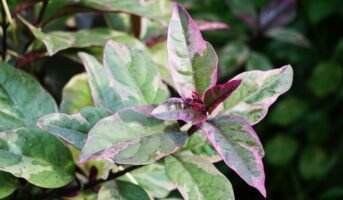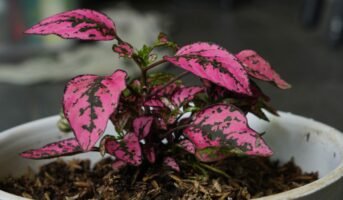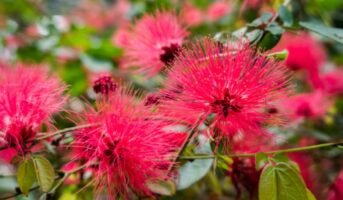Mussaenda is one of the most sought-after tropical shrubs because of its tremendous beauty, displayed by highly coloured flower bracts that bloom throughout the warmer and hotter months of the year.
As a result of its vibrant petiole bracts, Mussaenda has become a widely used decorative shrub. It belongs to the family Rubiaceae of plants and is commonly known as Ashanti blood or red flag bush. This article discusses the cultivation and maintenance of a shrub.

Source: Pinterest
Read about topiary
Mussaenda: Key facts
| Scientific Name | Mussaenda |
| Family | Rubiaceae |
| Common Name | Ashanti blood, red flag bush |
| Sun Required | Full sun to partial sun |
| Blooming Time | Seasonal bloomer |
| Soil | Well-drained soil |
| Soil pH | 6.0-7.5 |
Mussaenda: Features
- This evergreen shrub may reach a height of 2 metres.
- Its opposing leaves are approximately 21 × 8 centimetres, with prominent veins and hairs on both surfaces.
- Flowers are arranged in terminal clusters, and each flower has five sepals, of which at least one is expanded and coloured, often in the range of white to apricot.
- In some cultivars, all sepals are enlarged and the golden corolla is tubular.
- Fruits of Mussaenda are blackberries.
Mussaenda: How to plant?
- In the summer, you can root stem cuttings from evergreen shrubs by cutting off a few inches of healthy new growth, removing the lowest leaves, and sticking the cuttings into a pot of potting soil or a garden with good drainage and bright indirect light.
- Before putting cuttings in their containers, they need to be kept damp for four to six weeks so that the roots can grow well.
- A plant’s ability to root can be improved using rooting hormones; however, these chemicals are usually unnecessary.
- Dig trenches or beds wide, not deep. Organic matter should be worked into heavy clay or sandy soils very lightly. Carefully remove plants from containers while preserving the integrity of the root ball.
- Plant at the same level as the surrounding soil while spreading the roots outward. Loosen the potting soil and roots around the bottom and borders of the root ball.
- Water should be used to settle the dirt around the roots after it has been filled with native soil that has been mildly altered.
- The area should be covered with a layer of leaves or bark mulch one to three inches thick but should not be piled onto the plant’s stem or trunk.
- Water profoundly.
- Large bushes and trees should be tied down so the wind doesn’t move them too much.
Mussaenda: Maintenance
Watering
In contrast to annuals and herbaceous plants, woody plants require less regular watering.
Watering from a hose or sprinkler should be done slowly and adequately but not frequently. This minimises shallow root development or root infections. Most established trees, shrubs, and vines may go weeks without supplemental watering except in exceptionally hot or windy conditions. Don’t water until the top several inches of soil have dried up.
Use and maintain water-saving soaker hoses or drip irrigation as much as possible, especially in dry climates. Drying out, apart from the cold, is the primary cause of damage in winter. Keep the soil moist, not wet, by watering lightly twice or thrice weekly. Water loss can be reduced by using mulch in dry, windy, or sunny climates.

Source: Pinterest
Pruning
When shaping or training plants into hedges, topiary, espaliers, or other unusual shapes, pruning serves many purposes, including size management and pedestrian safety, the removal of dead or diseased sections, and aesthetic appeal.
Evergreen and deciduous broadleaf plants can be pruned as much as needed, even to the trunks. New shoots will appear close to the severed ends.
Pollarding is the practice of cutting back trees to make them grow bushier. Most neighbours don’t like it, but it benefits the trees in the long run.
Pests and diseases
No significant pest or disease problem exists for these plants, more so if their needs for food and temperature are addressed. They may be attacked by millie bugs, which can lead to the growth of sooty mould. Due to the hot and dry weather, these insects are more prevalent. Outdoor plants can also attract spiders, mites and whiteflies.
Fertilising
Apply fertiliser during the beginning of the plant’s active growth period, which is in the spring for summer plants and the fall for winter plants. Select a fertiliser with a higher nitrogen and phosphorus content if you want your plants to bloom or produce fruit.
If you’re applying fertiliser that dissolves in water, do these things:
- Follow the mixing instructions on the packaging for the best results.
- Wet the leaves and saturate the ground with the mixture.
- Repeat.
When applying fertiliser in granule form:
- Put a thin layer of general-purpose fertiliser under your plants from the base to the furthest branches or leaves.
- Water slowly and thoroughly.
General care
- Mussaenda needs temperatures well above freezing in order to grow. This means that its growing season is usually from the middle of January to the end of the year.
- You should move your plant from full sun to partial shade and provide some protection from the wind.
- During the hot months, they grow quickly, but their branches are still somewhat bendy, so there is always a chance that they will break in exposed places.
- The bark mulch should be placed around the plant at a depth of two inches. It should be held at least 3 inches away from the base of the bush.
- These bushes aren’t picky about their environment, but when spring arrives and the leaves begin to sprout, they need a decent meal and some vigorous pruning.
Mussaenda: Uses
Due to their height, Mussaenda bushes are typically placed at the back of a garden, so if you want to hide the bare ground at their feet, you can do so by planting a low-growing ground cover or another bush. To do this, you need to pick plants that have a fighting chance against the plants you’ve chosen.
Medicinal benefits
- Problems with vision, skin infections, TB, open sores, wounds, asthma, and respiratory illnesses, including the common cold and bronchitis, can be treated.
- Leprosy can be treated with a decoction made from the root.
- Jaundice can be treated using a decoction made from leaves and milk.
- A floral decoction is used to stimulate urination.
- Asthma, intermittent fevers, and oedema can all be treated with the same flower preparation.
- Ulcers can be treated by using a paste made from flowers and leaves.
FAQs
Are Mussaenda leaves safe to eat?
Yes. The leaves are chewed with betel and used as a poultice to treat headaches.
Can Mussaenda be grown in pots?
Yes. Plants can be cultivated in containers in cooler regions.
Housing News Desk is the news desk of leading online real estate portal, Housing.com. Housing News Desk focuses on a variety of topics such as real estate laws, taxes, current news, property trends, home loans, rentals, décor, green homes, home improvement, etc. The main objective of the news desk, is to cover the real estate sector from the perspective of providing information that is useful to the end-user.
Facebook: https://www.facebook.com/housing.com/
Twitter: https://twitter.com/Housing
Email: [email protected]

